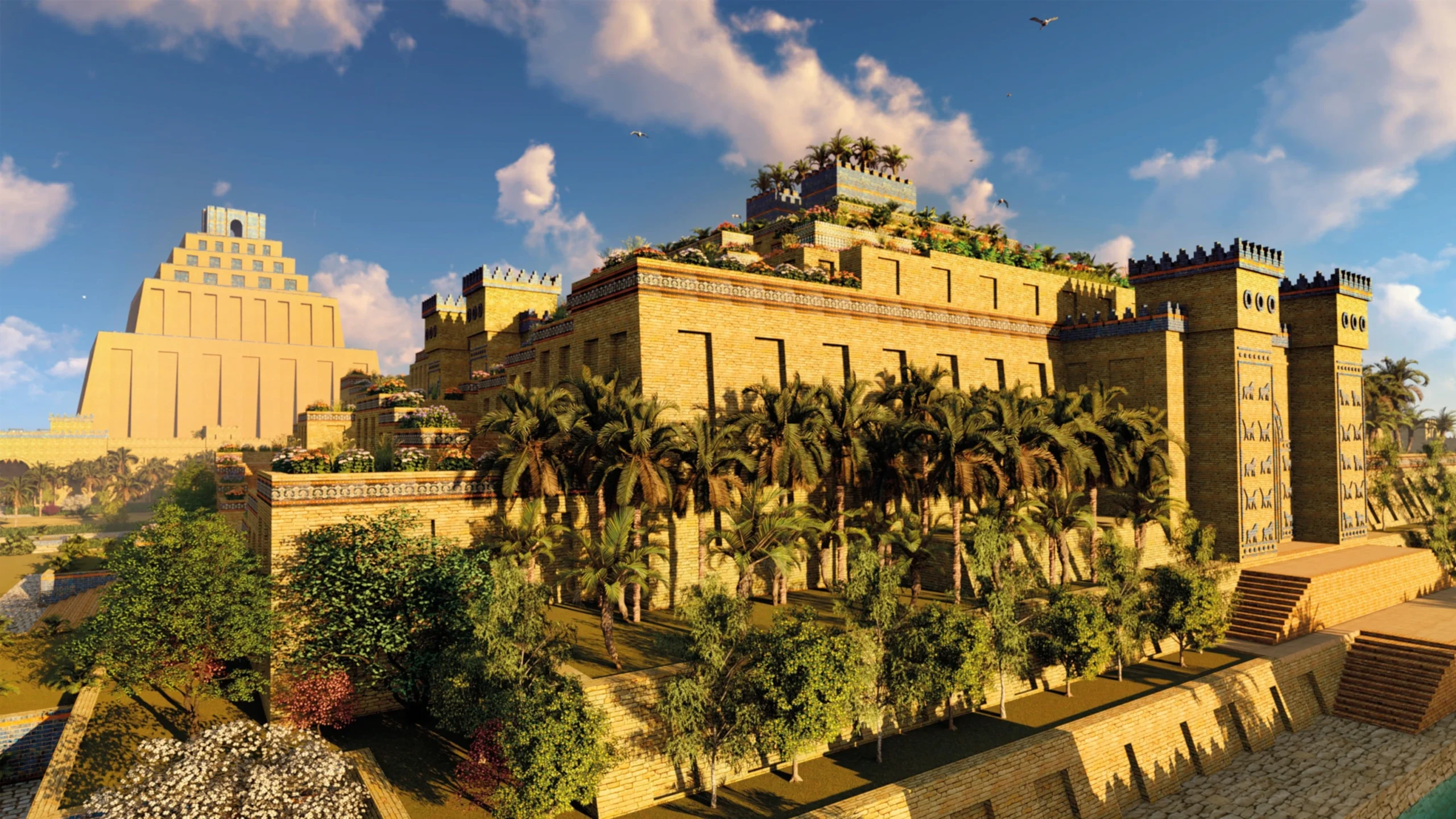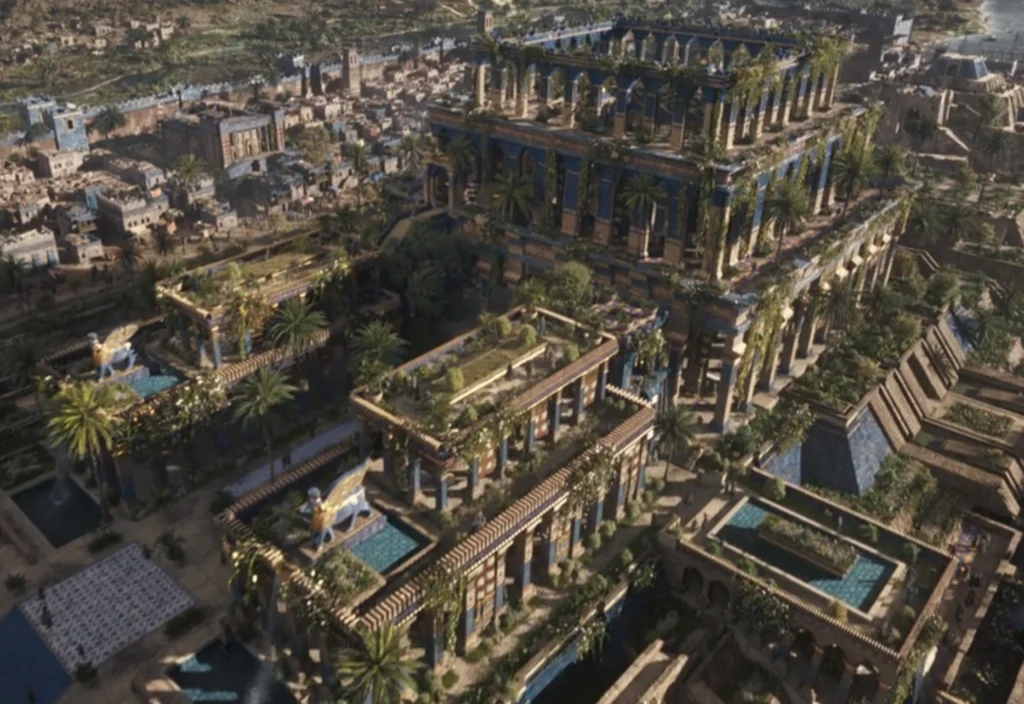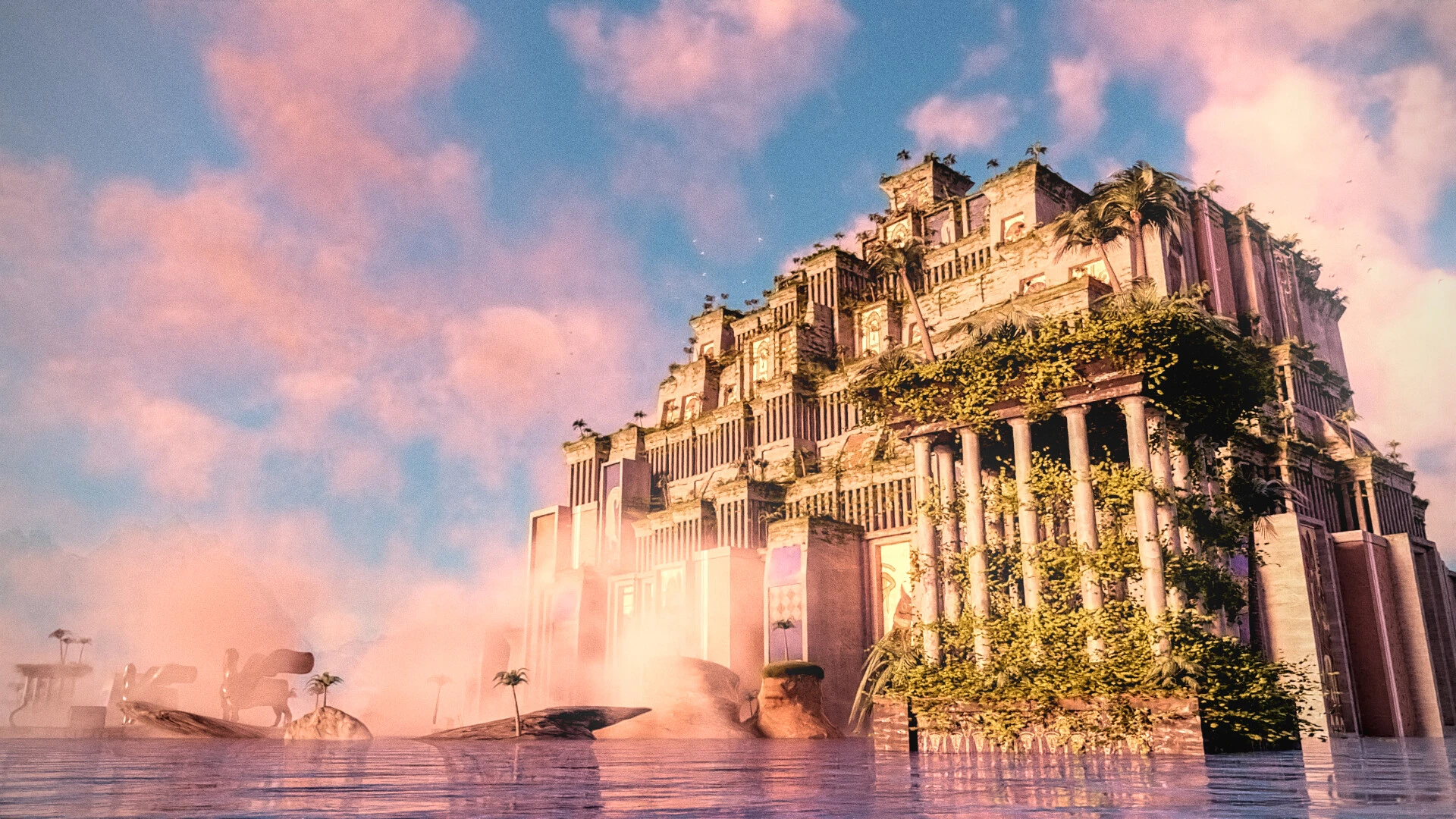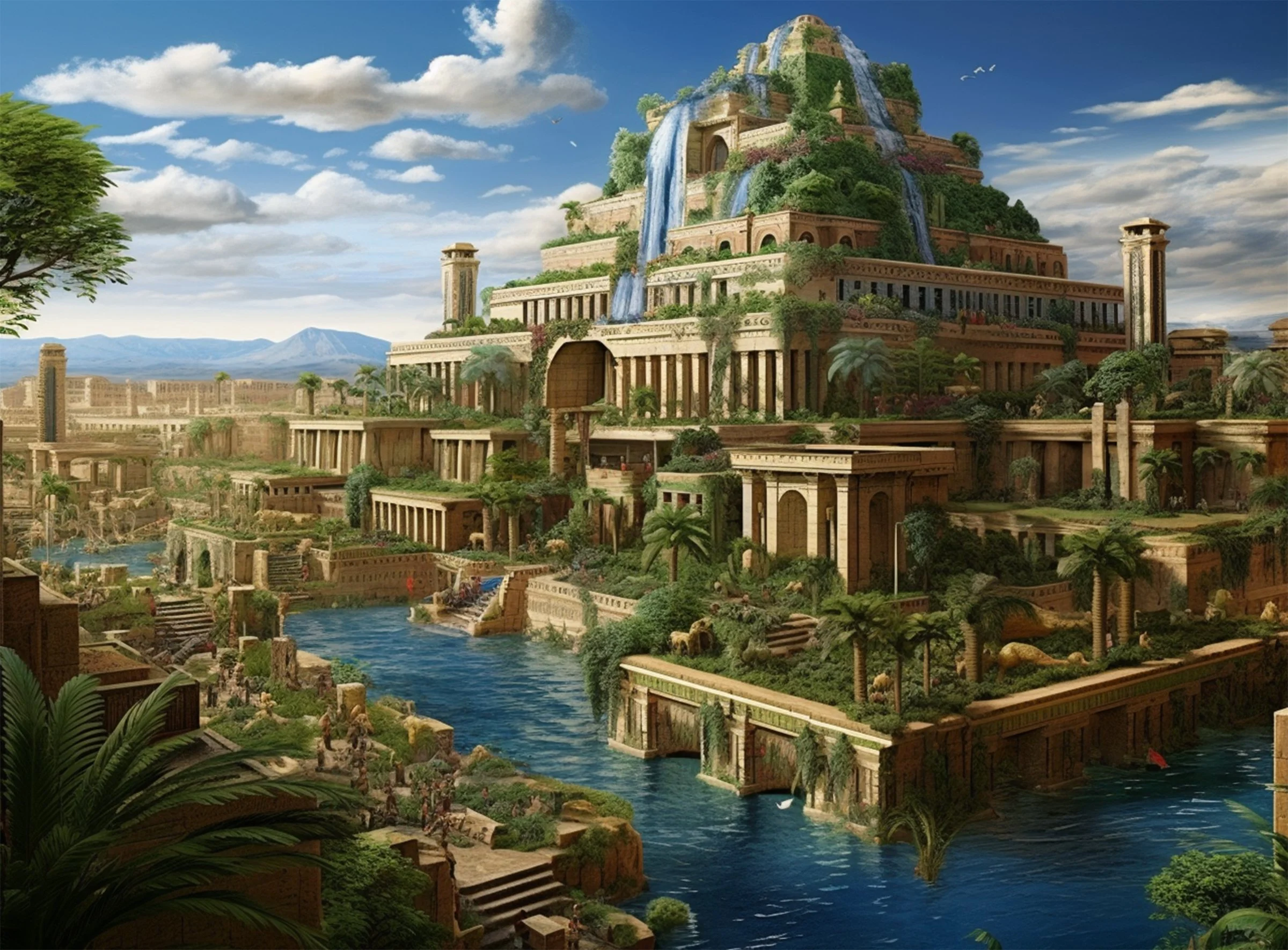Welcome to a majestic oasis suspended in time: the Hanging Gardens of Babylon. This ancient wonder, often hailed as one of the Seven Wonders of the World, continues to captivate imaginations with its ethereal beauty. In this article, we will delve into the rich history and lore surrounding this extraordinary feat of engineering and horticulture.
History and significance of the Hanging Gardenss of Babylon
Built in the 6th century BCE by King Nebuchadnezzar II, the Hanging Gardens were an architectural marvel nestled in the heart of Babylon, a thriving city located in present-day Iraq. According to historical accounts, the gardens featured a series of terraces adorned with lush foliage, vibrant flowers, and exotic plants, all irrigated by a sophisticated hydraulic system. It is believed that these magnificent gardens were created to appease the homesickness of the king’s wife, Amytis, who longed for the verdant landscapes of her homeland.
The Hanging Gardens of Babylon hold great significance in the annals of human history. They were not only a symbol of the king’s wealth and power but also a togelup testament to the advanced engineering and horticultural techniques of the time. The gardens showcased the mastery of irrigation systems, allowing the flourishing of diverse flora in a region known for its arid climate. These gardens were a sanctuary of beauty and tranquility, a testament to the importance placed on aesthetics and the connection between humans and nature.
The fame of the Hanging Gardens spread far and wide, attracting visitors from across the ancient world. They were described by historians such as Strabo and Diodorus Siculus, who marveled at their grandeur. The gardens became an integral part of Babylonian mythology and were often associated with the gods, further elevating their significance in the cultural and religious fabric of the era.

Description of the gardens’ architecture and design
The Hanging Gardens were a marvel of engineering and design. Built on a series of tiered terraces, the gardens created the illusion of a lush mountain rising from the flat plains of Babylon. These terraces, supported by sturdy stone columns, were filled with rich soil to accommodate the growth of various plants and trees. The gardens were arranged in a symmetrical fashion, with each terrace offering a unique display of flora, creating a visually stunning and harmonious landscape.
An intricate system of channels and pipes allowed water to flow from the Euphrates River to the highest terrace, ensuring the irrigation of the entire garden. The hydraulic system was a testament to the ingenuity of the Babylonians, utilizing the principles of gravity and hydraulic pressure to distribute water evenly throughout the gardens. This sophisticated irrigation system not only sustained the growth of plants but also contributed to the cooling and humidifying of the air, creating a microclimate that supported the flourishing of diverse vegetation.
The architectural elements of the Hanging Gardens added to their allure. The terraces were adorned with elaborate sculptures, colorful mosaics, and intricate frescoes, depicting scenes from Babylonian mythology and daily life. The combination of architectural grandeur and natural beauty created a sensory experience that left visitors in awe.
Theories and controversies surrounding the existence of the Hanging Gardens
Despite the historical accounts and descriptions, the existence of the Hanging Gardens of Babylon has been a subject of debate and controversy among archaeologists and historians. Some argue that the gardens were a figment of ancient imagination, a legendary creation that never truly existed. Others propose that the gardens did exist but were not located in Babylon, suggesting alternate locations such as Nineveh or elsewhere.
One theory suggests that the Hanging Gardens were not a standalone structure but rather a series of rooftop gardens adorning the palaces of Babylon. According to this theory, the term “hanging” refers to the gardens being suspended in the air, rather than being suspended from a structure. This interpretation offers a different perspective on the gardens, presenting them as a distributed network of green spaces rather than a single monumental creation.
The lack of physical evidence further complicates the debate. Despite extensive excavations in Babylon, no direct evidence of the Hanging Gardens has been found. However, the absence of evidence does not necessarily disprove their existence. It is possible that the gardens were destroyed or eroded over time, leaving behind minimal traces. The search for definitive proof continues, as archaeologists explore new avenues of investigation.
The role of the Hanging Gardens in ancient Babylonian society
The Hanging Gardens of Babylon held a significant role in ancient Babylonian society. They were not only a symbol of the king’s power and wealth but also a testament to the importance placed on aesthetics and the connection between humans and nature. The gardens were a place of respite and leisure for the residents of Babylon, providing a sanctuary of beauty and tranquility amidst the bustling city.
The gardens also played a political role, serving as a diplomatic gift and a demonstration of the king’s magnificence. According to historical accounts, Nebuchadnezzar II built the gardens to appease his wife’s homesickness. By creating a replica of her homeland’s lush landscapes, the king aimed to ensure her happiness and strengthen their marital bond. The gardens were a testament to the king’s devotion and the lengths he was willing to go to please his queen.
Furthermore, the gardens showcased the advanced engineering and horticultural techniques of the Babylonians. The mastery of irrigation systems allowed the flourishing of diverse flora in an otherwise arid region. The technological achievements of the Hanging Gardens demonstrated the ingenuity and resourcefulness of the Babylonian civilization, solidifying their reputation as a center of innovation and sophistication.

The influence of the Hanging Gardens on future garden design
The Hanging Gardens of Babylon left a lasting impact on the world of garden design. Their grandeur and beauty inspired future generations to create their own versions of suspended gardens and lush landscapes. The concept of tiered gardens, with terraces adorned with vibrant plants and water features, became a popular design element in various cultures.
One notable example of the influence of the Hanging Gardens can be seen in the Mughal gardens of India. These gardens, such as the famous Shalimar Bagh in Kashmir, feature terraced layouts, flowing water channels, and lush vegetation, reminiscent of the Babylonian gardens. The Mughal emperors drew inspiration from the grandeur of the Hanging Gardens, incorporating similar design elements into their own gardens as a symbol of power and luxury.
The Hanging Gardens also influenced the development of formal gardens in European culture. The concept of creating structured, symmetrical gardens with geometric patterns and carefully selected plants can be traced back to the Babylonian gardens. European garden designers, such as André Le Nôtre, drew inspiration from ancient gardens, including the Hanging Gardens, as they shaped the iconic gardens of the Renaissance and Baroque periods.
Rediscovery and excavation of the Hanging Gardens
The Hanging Gardens of Babylon remained a subject of fascination and curiosity throughout history, inspiring explorers and scholars to search for their remains. However, despite numerous expeditions and excavations, the physical remains of the gardens have eluded discovery.
One of the most famous attempts to locate the Hanging Gardens was led by German archaeologist Robert Koldewey in the late 19th and early 20th centuries. Koldewey’s excavations in Babylon revealed the grandeur of the ancient city but yielded no conclusive evidence of the Hanging Gardens. Nonetheless, his work shed light on the advanced engineering and urban planning of Babylon, contributing to our understanding of the city’s historical significance.
Modern technology has also been employed in the search for the Hanging Gardens. Satellite imagery and remote sensing techniques have been used to identify potential locations and anomalies that may indicate the presence of underground structures. These methods have provided promising leads, reigniting hope that the physical remnants of the gardens may one day be discovered.
Modern-day interpretation and recreation of the Hanging Gardens
While the physical gardens may no longer exist, efforts have been made to recreate the Hanging Gardens of Babylon in modern times. These recreations offer visitors a glimpse into the splendor and beauty that once graced the ancient city of Babylon.
One such recreation can be found in the city of Al-Hillah, Iraq. Known as the “Hanging Gardens of Babylon” theme park, this ambitious project aims to recreate the gardens on a smaller scale. Featuring terraced gardens, water features, and lush vegetation, the park provides visitors with an immersive experience that transports them back in time to the era of the Hanging Gardens.
Another modern interpretation of the Hanging Gardens can be seen in the vertical gardens that have gained popularity in contemporary architecture. These gardens, often created using green walls and living facades, evoke the spirit of the Hanging Gardens by bringing nature into urban environments. Vertical gardens not only enhance the visual appeal of buildings but also contribute to air purification and the well-being of urban dwellers.

Tourist attractions and visitor experiences at the Hanging Gardens site
While the physical remains of the Hanging Gardens have yet to be definitively discovered, the site of Babylon itself remains a significant tourist attraction. Visitors can explore the ruins of this ancient city and immerse themselves in the rich history and culture of the region.
Tourists can visit the ruins of the Ishtar Gate, one of the main entrances to the city of Babylon, adorned with meticulously reconstructed blue-glazed tiles depicting mythical beasts and deities. The nearby Babylonian Museum offers a collection of artifacts and exhibits that provide insight into the daily life and achievements of the Babylonian civilization.
Exploring the city of Babylon allows visitors to walk in the footsteps of ancient kings and queens, experiencing the awe-inspiring grandeur that once defined this magnificent city. Although the Hanging Gardens may remain a tantalizing mystery, the enduring legacy of Babylon is a testament to the enduring power of human creativity and ingenuity.
The enduring legacy of the Hanging Gardens of Babylon
The Hanging Gardens of Babylon continue to captivate our imaginations, even though their existence is shrouded in mystery and debate. As one of the Seven Wonders of the World, they hold a special place in the annals of human history and remain a testament to the power of human creativity and ingenuity.
Whether the gardens were a figment of ancient imagination or a true architectural marvel, their allure endures. The stories and legends surrounding the Hanging Gardens have inspired generations, sparking curiosity and fascination with the ancient world. Their influence on garden design and the cultural significance they held in ancient Babylonian society are testaments to their enduring legacy.
If you found this article fascinating, we invite you to delve deeper into the rich tapestry of ancient civilizations by reading our piece on the Royal Family. Discover more captivating stories and unravel the mysteries of the past with us.




